Putin Is Bulldozing Russia’s Energy Exports and Pushing the Energy Transition

Table of Contents
Author(s)
Share this Publication
- Print This Publication
- Cite This Publication Copy Citation
Jim Krane, "Putin is Bulldozing Russia's Energy Exports and Pushing the Energy Transition" (Houston: Rice University’s Baker Institute for Public Policy, February 7, 2023), https://doi.org/10.25613/AGZM-MW83.
Who would have imagined that the czar of an autocratic petrostate would end up driving Europe to renewable electricity, battery-powered cars, and electric heat pumps?
That’s exactly what Russian President Vladimir Putin is doing, while simultaneously subverting the exports of oil and natural gas that support the Russian government and military.
The big takeaway is that switching to systems based on clean electricity — renewable and nuclear power — not only helps the climate, it also reduces exposure to the chaos caused by abuse of cross-border fuel supply chains.
Fatih Birol, executive director of the International Energy Agency, summed it up: “More low-carbon energy would have helped ease the crisis — and a faster transition from fossil fuels towards clean energy represents the best way out of it.”
In short, Putin’s attempt to leverage the country’s exports to pressure European leaders into accepting his invasion of Ukraine has backfired. The price of this mistake is enormous. Putin has relinquished his largest market and stranded thousands of miles of oil and gas pipelines.
EU Accelerates Move to Clean Energy
The EU’s supply of natural gas, in particular, has long been exposed to political risk. EU-bound gas pipelines originate in Russia, Turkmenistan, Algeria, Azerbaijan, Libya, and Norway. Along the way, those lines cross Belarus, Ukraine, Kazakhstan, Moldova, Turkey, Georgia, Tunisia, and Morocco. Each of these 14 countries has veto power on EU gas deliveries.
Now that the latent risk of disruption has become reality, the EU is dashing toward energy independence through the REPowerEU plan. New rules mandate quick approvals of clean power generation. The EU now wants heating and cooking electrified and gas prioritized for backup power.
Already, wind and solar generation have jumped from 13% of the EU’s power production in 2015 to 22% in 2022. Wind and solar have surpassed natural gas — 20% of power production last year — for the first time ever. Capacity growth is expected to increase. Nuclear and hydropower both declined last year, due to drought and maintenance problems. But several European countries, mainly in the East, now plan to increase nuclear generation.
Fixing Political Risk
The EU’s clean electricity quest was previously billed as climate action. But it has also been about insulating a resource-deficient continent from the spiking cost of fossil fuel imports and the whims of authoritarian exporters.
Renewables and nuclear power offer the best protection. Renewables, once installed, have zero import requirements. Nuclear fuel can be purchased in advance and stockpiled for years. Neither depends on the type of 24/7 year-round supply chain that tethers fossil generation to suppliers, including those tempted to political subjugation. The more power the EU generates from renewables, the smaller its exposure to those risks.
The same logic holds for drivers trading gasoline-powered cars for electric vehicles, and homeowners swapping gas-fired boilers for electric heat pumps. The switch protects them from the geopolitics that affect oil and natural gas prices, whether due to Russian embargoes, OPEC cuts, or Iranian missiles.
That means the upheaval Europe is undergoing in replacing Russian energy may be worthwhile, if the end result is a cleaner, secure, and self-sufficient power grid.
For now, the public is on board. In November, EU-wide polling found more than 8 in 10 citizens agreeing that the invasion of Ukraine made investment in renewables more urgent. Another 58% said the same for nuclear. And 82% of citizens agreed that the EU should continue reducing dependence on Russian oil and gas. (See Figures 1 and 2.)
Figure 1— Eurobarometer Poll on the EU’s Response to Energy Challenges, Q7.1
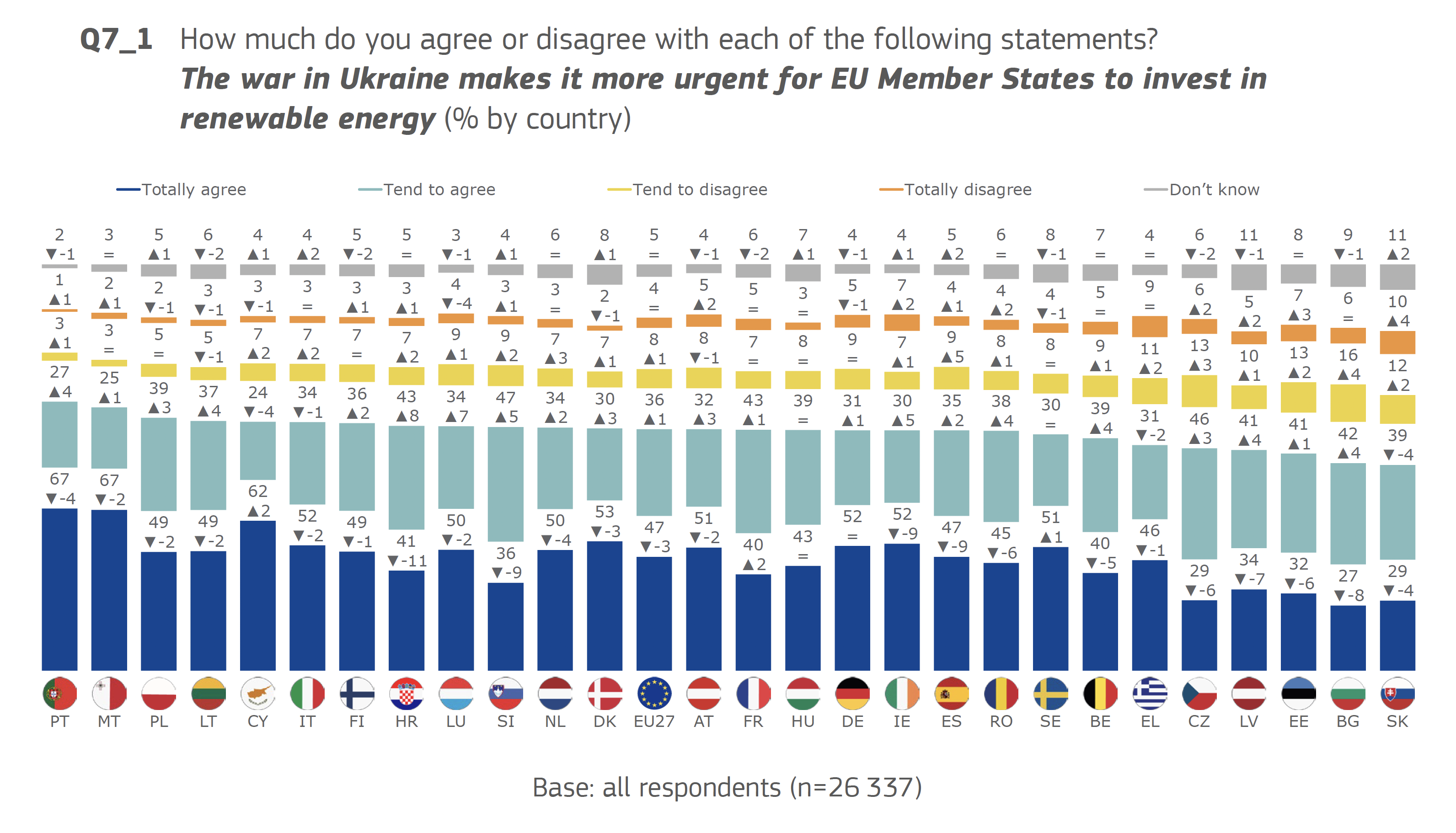
Source: Ipsos European Public Affairs, https://europa.eu/eurobarometer/surveys/detail/2912.
Figure 2 — Eurobarometer Poll on the EU’s Response to Energy Challenges, Q7.2
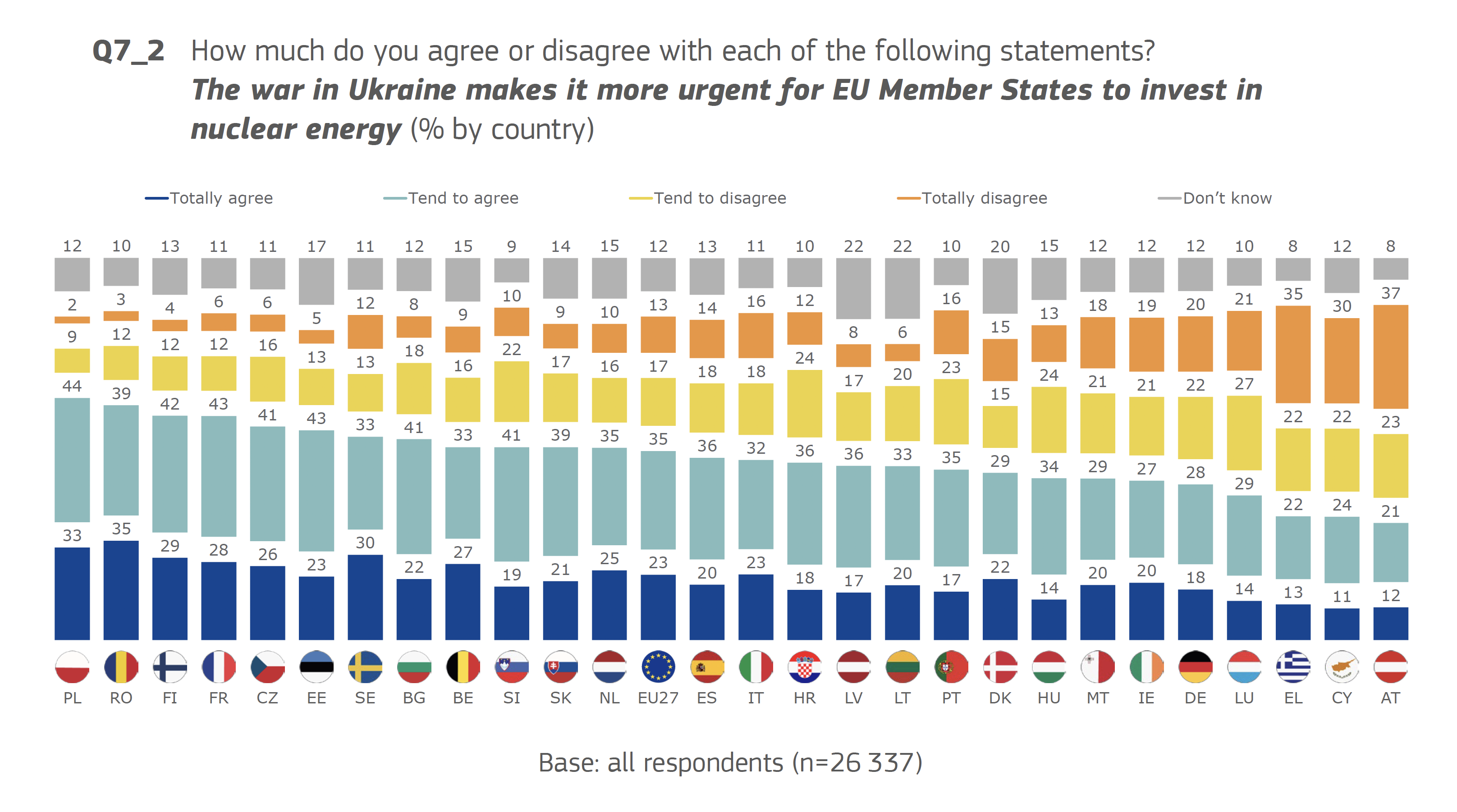
Source: Ipsos European Public Affairs, https://europa.eu/eurobarometer/surveys/detail/2912.
EU Gas Demand Falters
There is no denying that 2022 was a tough year for Europe. Since Russia invaded Ukraine in February 2022, Russian pipeline gas deliveries have plummeted, dropping from 167 billion cubic meters in 2021 to an expected 25 bcm this year — the lowest level since the onset of Soviet exports in the 1980s.
More worrying is that EU gas consumption is also being reduced by a steep decline in industrial use. (See Figure 3.) If EU gas prices remain uncompetitive, the bloc could lose its energy-intensive industry to cheaper locales, including the United States.
Figure 3 — Monthly Natural Gas Demand in Germany, 2019-2021 Average vs. 2022
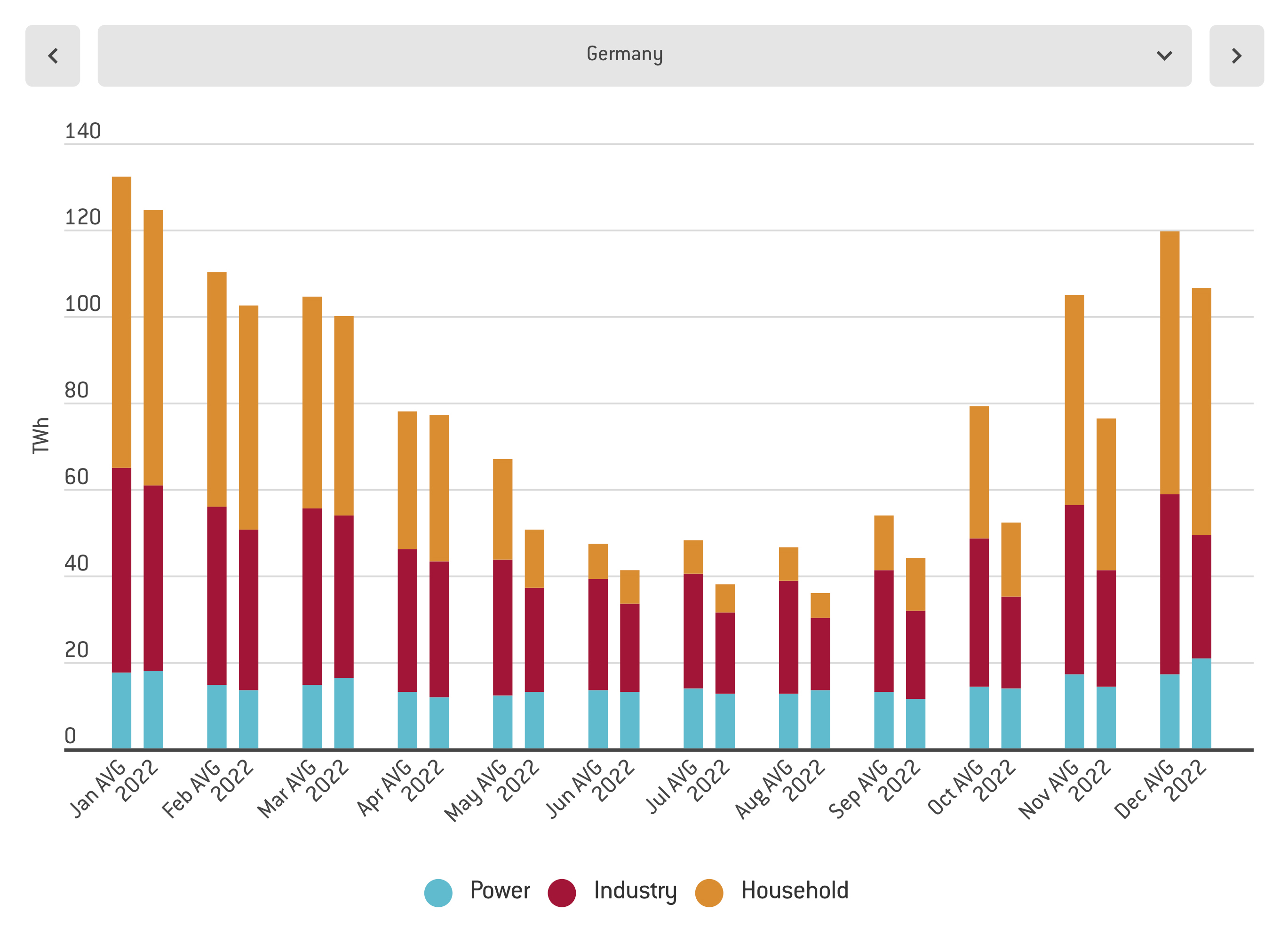
Source: Breugel, https://www.bruegel.org/dataset/european-natural-gas-demand-tracker.
Renewables Face Hurdles Too
Globally, renewables are already capturing 70% of investment in energy, eclipsing upstream oil and gas. Pushing the transition harder will be mammoth EU spending on renewable power and competition from the U.S. through the Inflation Reduction Act.
Ramping up wind and solar brings its own set of risks. Supply chain bottlenecks could delay the EU buildout via price spikes in materials like copper, silver, and rare earth elements. Even if the EU manages to cope with higher costs, competition for scarce materials could force delays in clean energy investment in poorer countries, pushing them to coal or natural gas.
The EU also needs transmission capacity to move electricity from sunny and windy parts of the continent to the big cities. And the intermittency of renewable power production renders it dependent on dispatchable backup generation, best done with — you guessed it — natural gas.
These hurdles mean the EU’s power mix will need fossil fuels for some time.
Blowback for Russia
The most breathtaking energy outcome of a turbulent 2022 was Russia’s loss of its largest export market. It may not have received much media attention, but Russia’s dependence on Europe was actually greater than the other way around.
In recent years, the EU was the destination for as much as 90% of Russia’s total gas exports. In 2021, Europe was still taking 83% of the country’s gas exports, according to BP data, and more than half of Russia’s crude and refined product exports. The Russian government depended on EU cash to fund half its budget.
That relationship, dating to the 1980s, has collapsed.
In early 2023, EU imports of Russian gas were roughly 13% of the prior year’s and falling. (See Figure 4.) When the EU’s total ban on imports of Russian oil and refined products is phased in, Russian oil will have lost the market it dominated for so long.
Figure 4 — Monthly Pipeline and LNG Imports from Russia and Other Sources
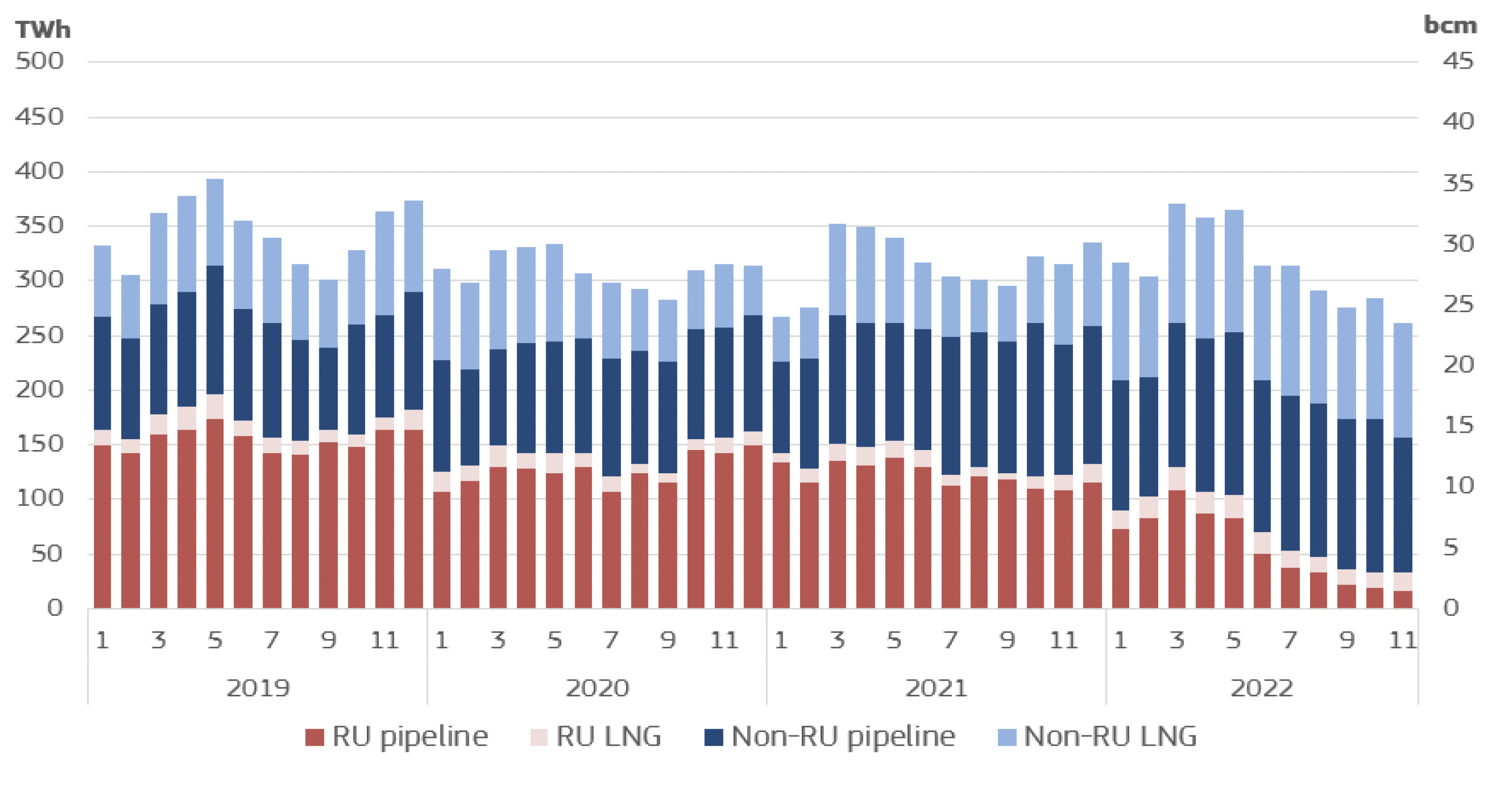
Source: European Commission Quarterly Gas Market Report Q3 2022, January 13, 2023.
The consequences are only starting to be felt.
Already, Gazprom’s data shows Russian gas production down 20% — from 515 bcm in 2021 to 413 bcm in 2022 — with exports at their lowest point since the demise of the Soviet Union. The IEA predicts Russia’s share of the global oil and gas trade will halve by 2030. (See Figure 5.)
Figure 5 — IEA’s Declining Outlook for Russian Oil and Gas Exports in 2030
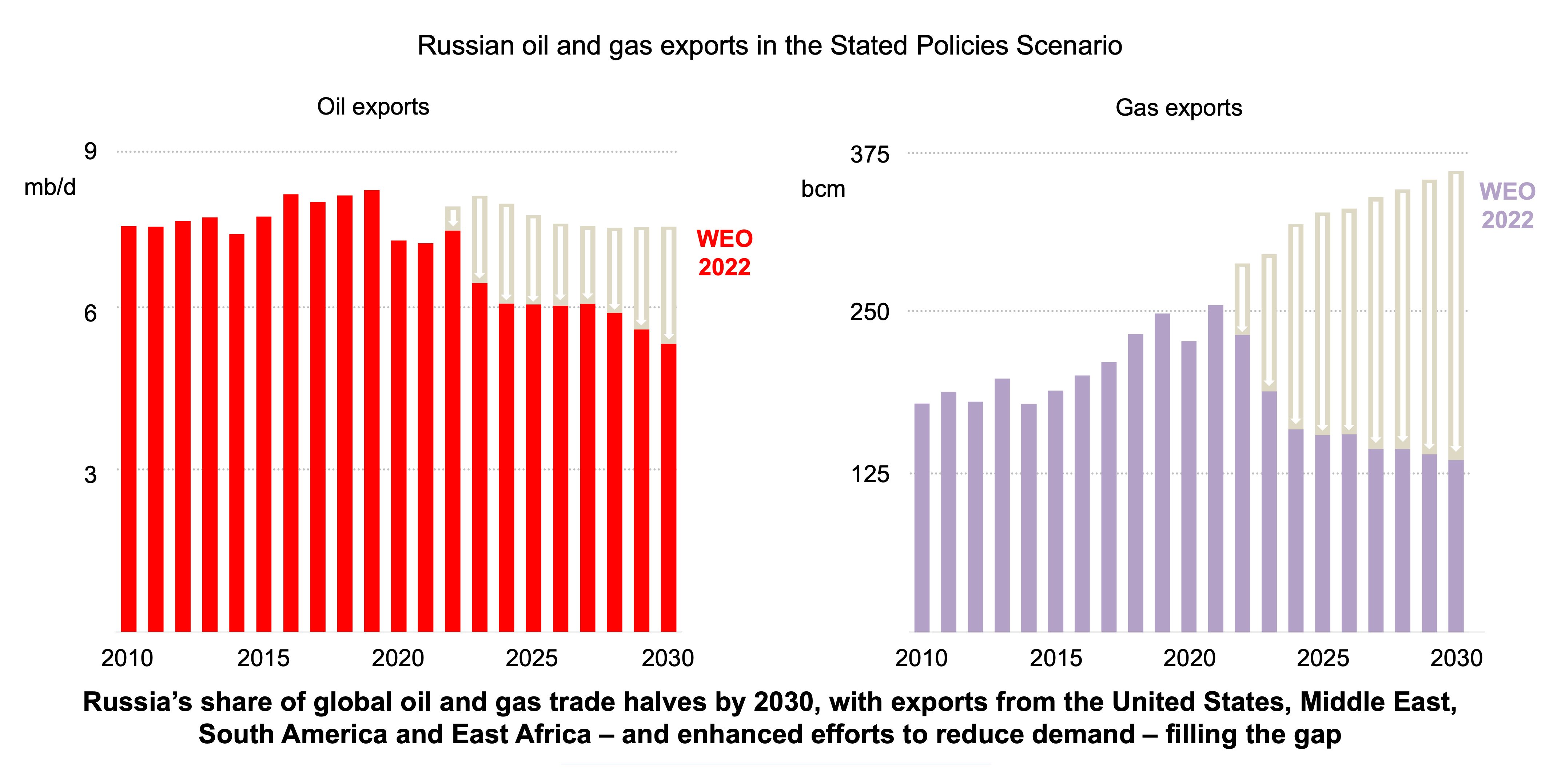
Source: IEA World Energy Outlook 2022.
Russia’s invasion is not just changing fossil fuel perceptions in Europe. Globally, the turmoil is highlighting the security advantages of nuclear and renewables. BP’s latest energy outlook shows a hastening shift toward clean energy due to cost and political risk to supply chains. (See Figure 6.)
Figure 6 — Changes in BP 2035 Energy Forecast Due to the Russian Invasion of Ukraine
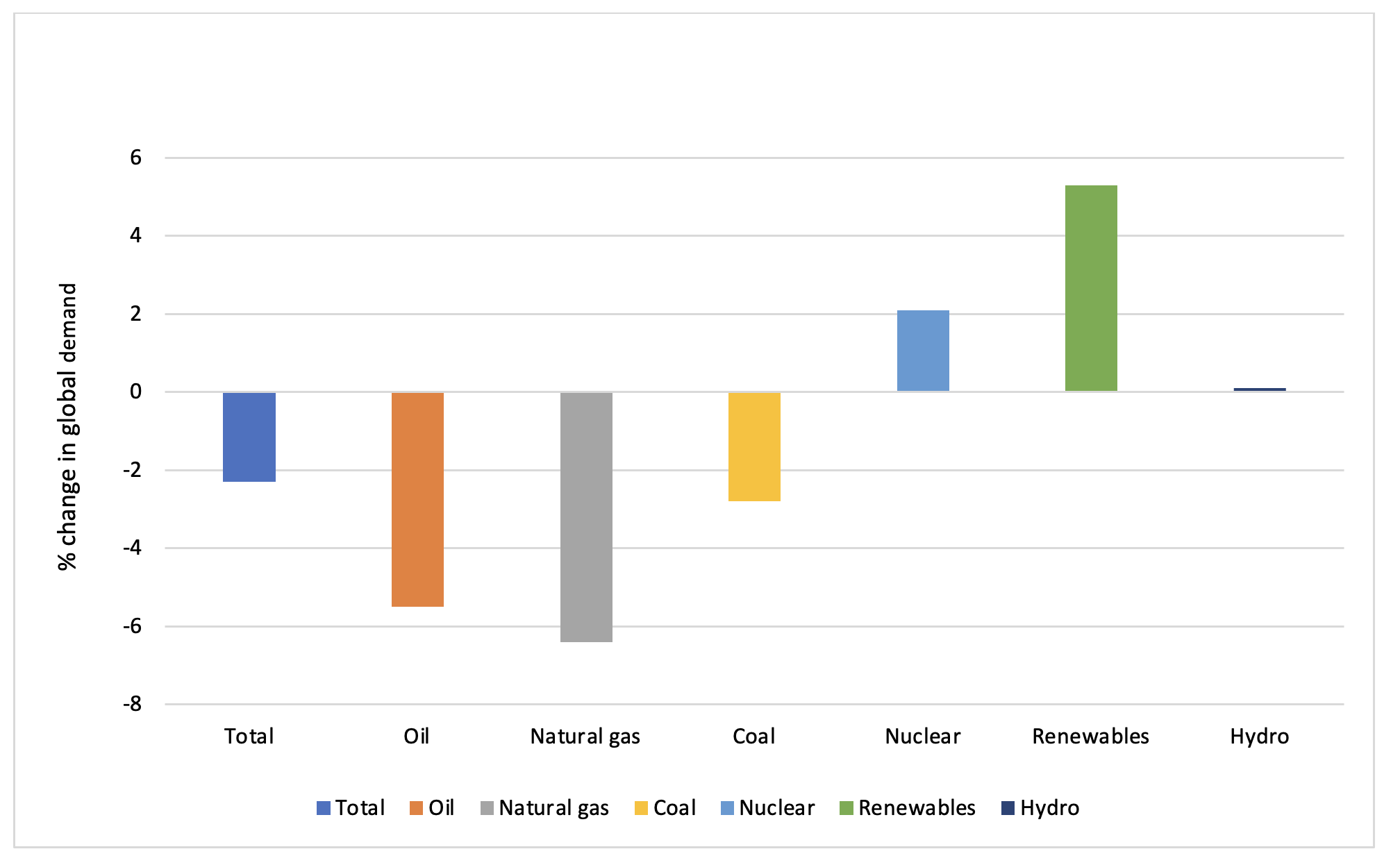
Source: “Main Changes Since Energy Outlook 2022,” BP, January 30, 2023, https://www.bp.com/en/global/corporate/energy-economics/energy-outlook/changes-since-energy-outlook-2022.html.
Erasing Putin’s Influence in the EU
For Putin, the changes represent a catastrophic failure. The Russian leader intended to use energy pressure tactics to force an EU climbdown over his invasion of Ukraine. Instead, his behavior undermined demand for fossil fuels, particularly Russian ones. Why did Putin’s strategy backfire?
An unusually warm winter helped by easing gas demand. But the big story is that substitutes for Russian fuels were available. Economics tells us that when substitutes appear, the market power of the incumbent is weakened. But because of the strategic value of oil and gas, substitutes are also weakening Russian geopolitical power.
Replacements for Russian gas include ship-borne liquefied natural gas. U.S. LNG is a big part of this story. A temporary increase in coal consumption was also necessary. Most of the Russian crude Europe consumed has been replaced by shipments from the Middle East. Russian oil now travels further away, mostly to Asia. Substitutes for fossil fuels had also matured enough to take some of the load.
All of these substitutes — along with efficiency and conservation — allowed the Europeans to retaliate with embargoes of their own. One emerging result is a bifurcation in global oil and LNG markets that harkens to the Cold War, with Russian energy moving to allied states while other importers seek supplies elsewhere. Shipping routes are growing longer and facing new geopolitical risks.
It seems that Putin’s advisers had not taken into consideration the steady annual improvement in energy security brought about by the EU’s decades-long shift toward renewables. They also overestimated the EU’s willingness to endure another politically driven Russian fuel cut, after troubling episodes in 2006 and 2009.
The invasion of Ukraine has backfired in many other ways, of course: It has rallied national sentiment in Ukraine, united the West in aiding Kyiv, forced the abandonment of Russian infrastructure, and resulted in the expansion of NATO and its military budget.
If Europe is able to extricate itself from Russia’s energy clutches by performing a clean energy reboot, we could see other risk-prone jurisdictions making similar calculations.
For these lessons in energy security, we have Vladimir Putin to thank.
This material may be quoted or reproduced without prior permission, provided appropriate credit is given to the author and Rice University’s Baker Institute for Public Policy. The views expressed herein are those of the individual author(s), and do not necessarily represent the views of Rice University’s Baker Institute for Public Policy.



